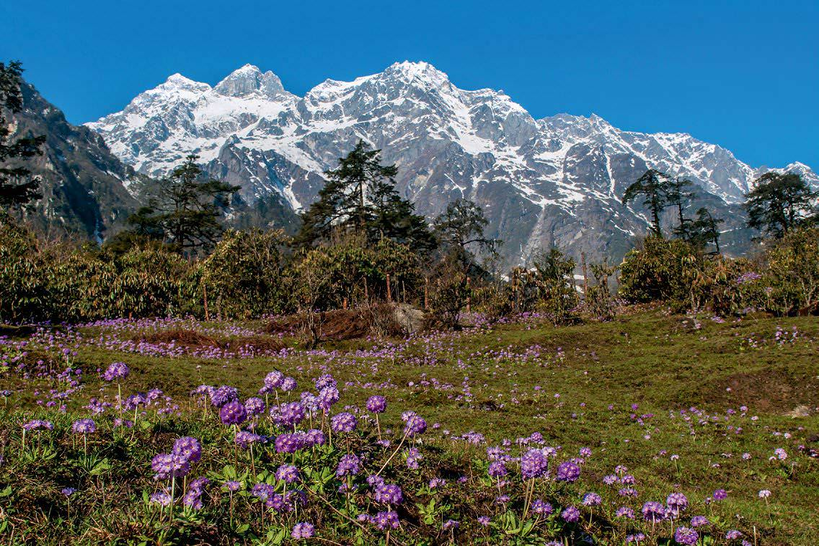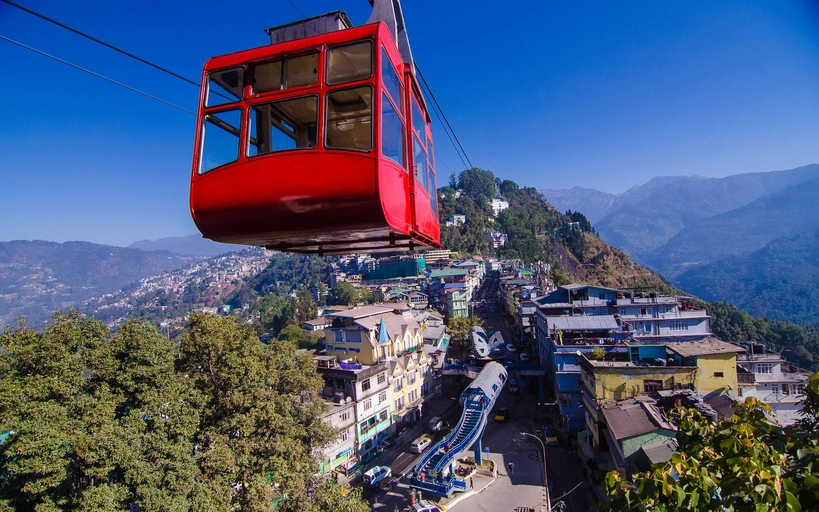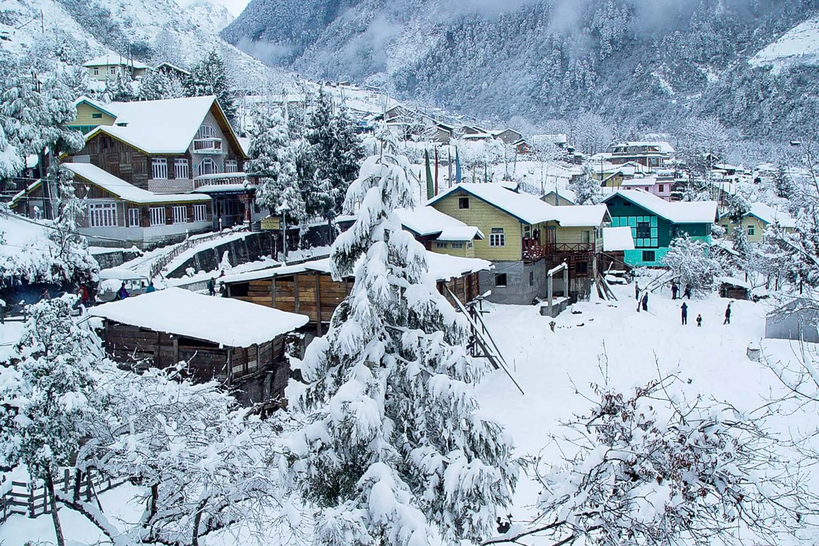Best time to visit Sikkim
The best time to visit Sikkim is based on the type of experience desired, as this Himalayan state offers unique attractions all year round. However, summer (April to June) and winter( November to March) are the best times to go. Although these times are often considered perfect, every season in Sikkim has a certain charm of its own. Summer (April to June) is a great time for those who enjoy the outdoors because of the pleasant weather, abundant vegetation, and blossoming flowers. Winter (October through March) offers a peaceful, snowy scene that gives visitors a new angle on the area. Travelers may see the state’s rich cultural diversity, tumbling waterfalls, and abundant biodiversity even during the monsoon season (July to October) when the landscapes are at their greenest.
You can also check our Sikkim Tour Packages.
Sikkim in Summer (April - June)

The summer months of April through June in Sikkim are a lovely time to visit the region, with nice weather, colourful sceneries, and an abundance of blossoming flora. In the valleys, Sikkim experiences temperatures between 15 and 25 degrees Celsius throughout these months, offering a pleasant and temperate environment. Travelers hoping to escape the intense heat found in many other regions of India may find this season especially alluring.
The region gradually shifts from the cold of spring to the warmth of summer, which begins in April. Magnolias, orchids, and rhododendrons are among the vibrant flowers that surround the landscapes, making for an eye-catching background. Gaining access to the higher regions allows you to see gorgeous views of snow-capped peaks and verdant meadows, such as Gurudongmar Lake and Yumthang Valley which are among the best places to visit in Sikkim.
In Sikkim, May and June represent the peak of summer. This time of year is great for outdoor activities like trekking and seeing the many monasteries and cultural sites dotted around the state, thanks to the bright skies and pleasant temperatures. During these months, the well-known Rhododendron Sanctuary near Yumthang Valley is in full bloom, offering visitors a captivating opportunity to enjoy nature.
While summer is Sikkim’s peak travel season, the state’s many attractions—luxurious scenery, blossoming flowers, and cultural events—make it a captivating travel destination for anybody looking for a refreshing vacation.
Sikkim in Monsoon (June - October)

Sikkim is known for its lush scenery, colourful foliage, and rhythmic pattern of rain during the monsoon season, which runs from July to October. Although the season highlights the natural beauty of the state, severe rainfall during this time of year raises some concerns, such as the possibility of landslides and the need for road closures.
Peak monsoon months, July and August, bring heavy and regular rains to Sikkim. The area experiences an amazing transformation, with the hillsides becoming a lush tapestry that displays a variety of flowering plants. The area is dotted with cascading waterfalls, and the monsoon rains add to the rich biodiversity of the area.
Though the environment is stunning, travellers should be aware of the difficulties the monsoon poses during this time of year. Higher elevations, where well-known locations like Nathula Pass are located, could be covered with mist, which could reduce vision. Travel plans may be affected in some locations by the possibility of landslides and road closures. But the monsoon also offers a chance to see the state’s natural beauty in a new light—that of misted hills and vividly coloured flowers in bloom.
The monsoon begins to slow down in September and October, bringing with it less rain and brighter skies. Travelers can continue to enjoy beautiful foliage during this transitional period, along with improved weather. For those who want to enjoy Sikkim’s unique beauty without the heaviness of the monsoon rains, now is the perfect time.
It is advised that visitors to Sikkim during the monsoon be updated about weather, road advisories, and any disruptions to travel. Despite the difficulties, the season provides a more tranquil and off-season experience that enables travellers to enjoy Sikkim’s rich biodiversity and stunning natural surroundings against the relaxing backdrop of rain.
You can also check our Sikkim Tour Packages.
Sikkim in Winter (October - February)

From October to February, Sikkim experiences a distinctive and peaceful winter makeover that is sure to captivate visitors who reach Sikkim . The area experiences a wide range of temperatures throughout this season, with higher elevations experiencing colder-than-freezing temperatures and lower altitudes having cool weather. A coating of snow often covers the landscapes, turning them into a tranquil winter wonderland.
While the upper regions may see their first sprinkling of snow in October, the lower elevations still have the fall colours. In November and December, as winter approaches, temperatures drop and there’s a chance of significant snowfall, particularly in areas like Lachung and Lachen. There may be a fair amount of snow covering the famous Tsomgo Lake and Nathula Pass, creating a stunning view.
Peak winter months in Sikkim are January and February when temperatures drop, skies are clear, and there’s a chance of snowfall in several spots, including Gangtok and the neighbouring districts. The winter season presents a rare chance to see Sikkim’s breathtaking scenery blanketed in snow, even though heavy snowfall may cause closed roads in some higher-altitude locations.
The month of March signifies the slow change from winter to spring. While some areas may still see snow, temperatures in lower elevations start to rise, and the scenery gradually awakens with the promise of springtime blooms. During this moment of transition, tourists can experience Sikkim in a more varied way, taking in both the last traces of winter and the first beginnings of spring.
Winter visitors to Sikkim can take advantage of the serene atmosphere, reduced crowds of tourists, and opportunities for various activities like snow trekking and taking in the Losar festival celebrations among the Tibetan Buddhist minority. A distinct viewpoint is offered by winter in Sikkim, when tourists may take in the quiet of the area amidst immaculate, snow-capped scenery. It’s a great place for people looking for a more relaxed, off-season holiday, but you should be ready for lower temperatures and some travel delays.
Things to consider before visiting to Sikkim
1. Permit Requirements: Special permits may be needed in some parts of Sikkim, particularly those close to international boundaries. You must check your permit requirements well in advance and get them via the correct channels.
2. Weather Conditions: Sikkim’s varied heights result in diverse weather conditions. Depending on the areas you plan to visit, travellers should pack for both warmth and cold, being ready for sudden changes in the weather.
3. Altitude Considerations: Sikkim has a lot of tourist spots that are situated at high altitudes. Take it carefully to prevent altitude-related problems. This applies especially to visitors who are unused to high elevations or have health concerns.
4. Road Conditions: Because the terrain of Sikkim includes mountain roads, the travel time between places may take longer. Therefore, it is recommended to plan your travel time accordingly and be ready for some adventurous trips.
5. Cultural Sensitivity: Sikkim has a rich cultural tapestry influenced by Tibetan Buddhism. Visitors should be respectful of local customs and traditions, particularly when visiting monasteries and religious sites.
6. Medical Facilities: While major towns have medical facilities, remote areas may have limited access to healthcare. Travelers should carry necessary medications, a basic first aid kit, and be aware of the nearest medical facilities.
Conclusion
In conclusion, the best time for Sikkim tourism will primarily rely on your interests and the kinds of experiences you want to have. But the months of March through May in the spring and September through November in the fall are usually thought to be the best times. The rhododendrons are in full bloom and the moderate weather makes for a beautiful scene in the spring. Autumn is the best season for outdoor activities and cultural immersion because it has good temperatures, bright skies, and exciting festivals. Plan your vacation based on your hobbies, whether it be hiking and outdoor adventures, taking in the natural beauty, or taking part in local celebrations. This will help you get the most out of your trip.
Also check our Sikkim Tour Packages.
People also ask about Things to do in Sikkim
March to May (spring) and September to November (fall) are the best times to visit Sikkim.
The springtime brings pleasant weather, rhododendron blossoms, and gorgeous scenery. It’s a great time for people who enjoy the outdoors and want to view vibrant flora.
Autumn, from September to November, provides pleasant temperatures, clear skies, and vibrant festivals. It’s perfect for trekking, cultural experiences, and outdoor activities.
From June to August, the monsoon season brings with it a lot of rain, landslides, and possible travel problems. If you want your trip to go more smoothly, you should stay clear of these months.
Yes, both spring and autumn are the best seasons to go trekking in Sikkim. Trekking routes like Goechala and Dzongri are popular in these seasons.
Permits may be required particularly in North Sikkim. To ensure a seamless travel experience, make sure you have the required permits in advance.
Sikkim has a high biodiversity, although individual wildlife encounters may differ. On the other hand, autumn and spring are excellent times for exploring the varied flora and animals and going birdwatching.
Considering altitude is essential, particularly in high-altitude regions. To avoid altitude sickness, acclimate gradually and bring along any essential medications.
You can visit monasteries and other cultural places in the recommended months. The overall experience of fully immersing oneself in the local culture is enhanced by the lovely weather.
